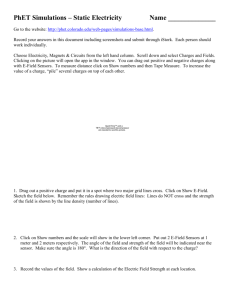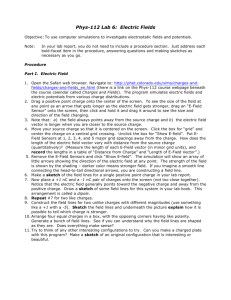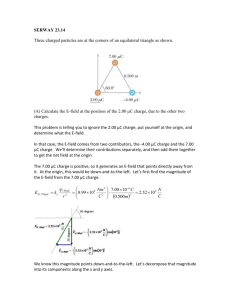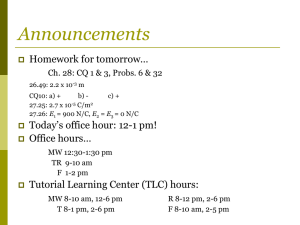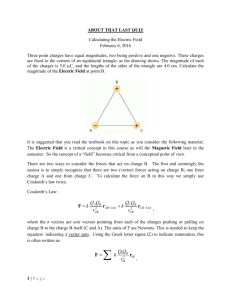PhET sim Electric Field Sim
advertisement
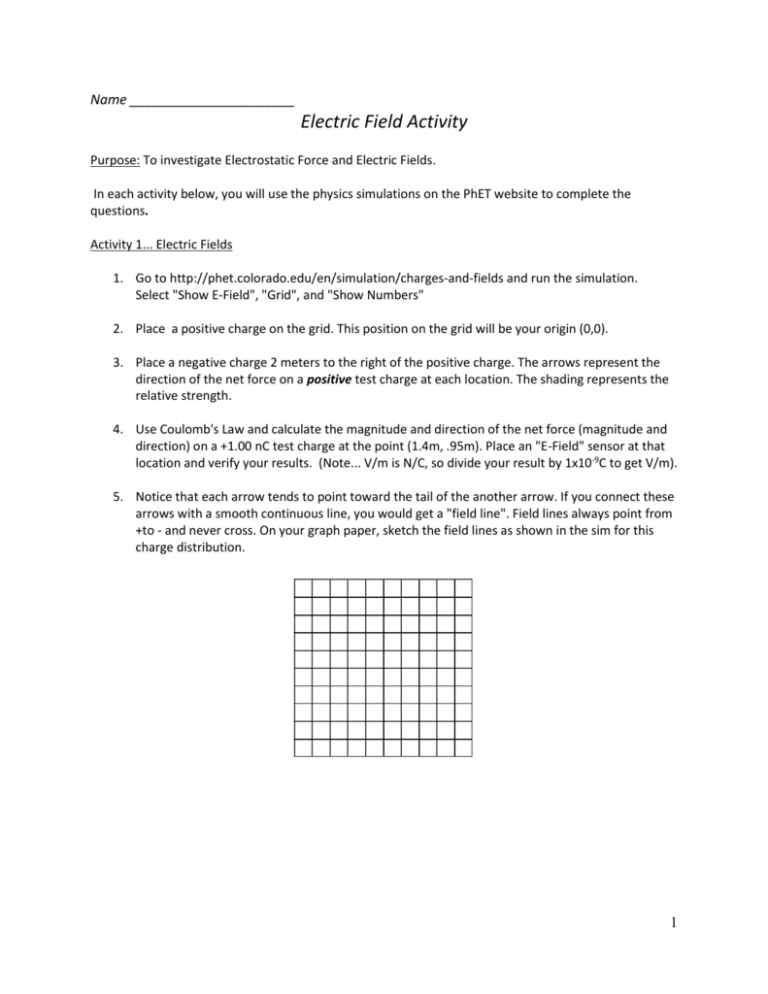
Name ______________________ Electric Field Activity Purpose: To investigate Electrostatic Force and Electric Fields. In each activity below, you will use the physics simulations on the PhET website to complete the questions. Activity 1... Electric Fields 1. Go to http://phet.colorado.edu/en/simulation/charges-and-fields and run the simulation. Select "Show E-Field", "Grid", and "Show Numbers" 2. Place a positive charge on the grid. This position on the grid will be your origin (0,0). 3. Place a negative charge 2 meters to the right of the positive charge. The arrows represent the direction of the net force on a positive test charge at each location. The shading represents the relative strength. 4. Use Coulomb's Law and calculate the magnitude and direction of the net force (magnitude and direction) on a +1.00 nC test charge at the point (1.4m, .95m). Place an "E-Field" sensor at that location and verify your results. (Note... V/m is N/C, so divide your result by 1x10-9C to get V/m). 5. Notice that each arrow tends to point toward the tail of the another arrow. If you connect these arrows with a smooth continuous line, you would get a "field line". Field lines always point from +to - and never cross. On your graph paper, sketch the field lines as shown in the sim for this charge distribution. 1 6. Hit "clear all", then place 4 positive charges on the grid. Place 1 negative charge 2 meters above the positive charges. On your graph paper, sketch the field lines... Happy Valentine's Day! 7. Hit "clear all", then place 2 positive charges on the grid horizontally two meters apart. On your graph paper, sketch the E-Field. 8. Use Coulomb's Law and calculate the magnitude and direction of the net force (magnitude and direction) on a +1.00 nC test charge at the point (1.0m, 0m) and the point (1.0m, 1.0m) Place an "E-Field" sensor at these locations and verify your results. Note... that there is some error due to the screen resolution. Keep this in mind as ponder future results. WRITE COULOMB’S LAW EQUATION, SHOW SUBSTITUTION, AND ANSWER IN PROPER UNITS. 2 9. Hit "clear all", then place 2 negative charges on the grid horizontally two meters apart. How is this E-Field similar to and different from the field with 2 positive charges. Why are they different? 10. Hit "clear all", then create a "dipole" by placing a positive charge right next to and above a negative charge. On your graph paper, sketch the E-Field. How does this compare to the earth's magnetic field? 11. Hit "clear all", then place 5 negative charges on the grid horizontally, each 0.5 meters apart. One meter above this, place a row of 5 positive charges, each 0.5 meters apart. On your graph paper, sketch the E-Field. What can you conclude about the electric field between the "plates", away from the ends? 3 12. Hit "clear all", then place 5 positive charges on the grid horizontally, each 0.5 meters apart. Two meters above this, place another row of 5 positive charges, each 0.5 meters apart. On your graph paper, sketch the E-Field. a. What is the magnitude of the field in the center between the plates? b. How would the field be similar and different if the charges were all negative? 13. Hit "clear all", the place 4 positive charges in a square with 2 meter sides. On your graph paper, sketch the E-Field. a. What is the magnitude of the field in the center of the square? b. How would the field differ if the charges were negative? c. Describe the field outside of the square... If you were looking at the field from 20 meters away, where would it look like all the field lines originated? 4 14. Create a 2m diameter circle of 12 charges. Be sure to space the charges equally around the circle. a. What is the magnitude of the field in the circle? b. From the outside, where does it appear the field lines originate? 15. In a conductor, electrons are relatively free to move, and due to the repulsive force between the electrons, the excess electrons will distribute uniformly on the surface. a. Based on your results, what is the magnitude of the electric field on the inside of a conductor? b. What does the electric field look like on the outside of a conductor? ... remember the charge carriers are negative. c. How could you "shield" an object from the effects of electric fields and forces? d. You are flying in an airplane and it gets struck by lightning... will you get shocked or electrocuted? Why or why not? e. You are driving your car in a thunderstorm and get struck by lightning... what happens to you? 5
